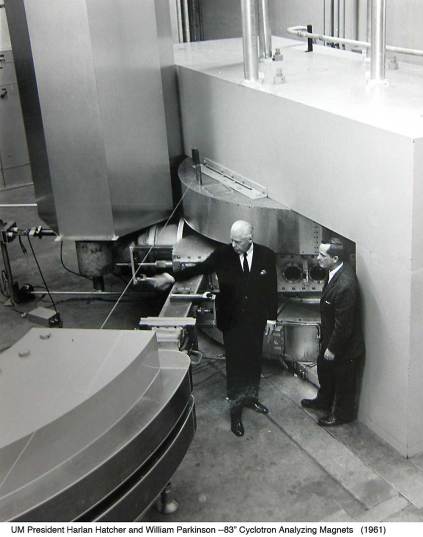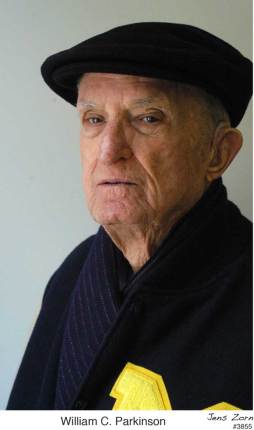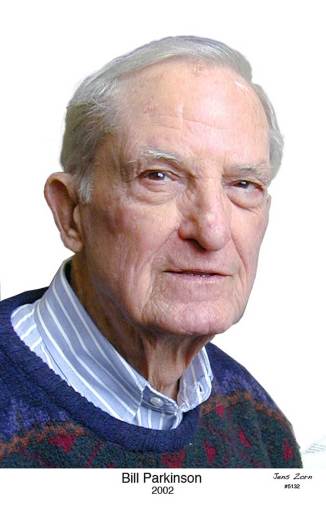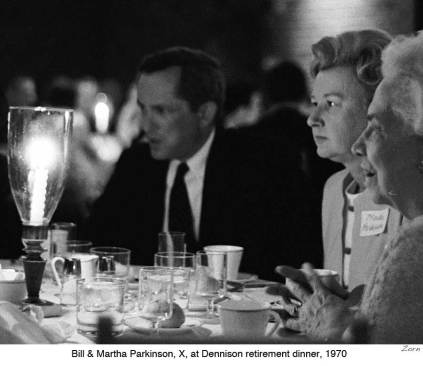William C Parkinson, Professor Emeritus of Physics at the University of Michigan, passed away on Monday, March 19, 2012, at University Senior Living in Ann Arbor. He was 94. Parkinson’s early research in nuclear physics pioneered the development of high resolution nuclear spectroscopy using cyclotrons. (click on “William Parkinson” title for more)
Born in Jarvis, Ontario, Canada on February 11, 1918, to Charles F. and Euphemia A. Parkinson, at a young age Bill moved with his family to Wyandotte MI then to Ann Arbor in 1932 becoming a naturalized citizen in 1942. A resident of Ann Arbor for 80 years he enrolled in the Engineering Physics Program at the University of Michigan in 1935. The summer after his sophomore year he approached the Chairman of the Physics Department (and Director of the Physical Laboratory) Professor H.M. Randall about a job and as an assistant in his laboratory. Bill found working with Professor Randall an invaluable experience, not just in the work they collaborated on in infrared spectrometry, but in the people he met and the mentorship they provided in preparing Bill for a long career as a research physicist. He recalled how particularly generous Professor Randall was with his students and hourly help when, assisting Randall on a contract with Gulf Oil, Bill was paid a dollar an hour, ‘a rate so generous it was unheard of when the going hourly rate was 35 cents!
During his undergraduate years Bill played French Horn in the University of Michigan Marching Band and held great respect for band director, William D. Revelli. “I played under the baton of Revelli during the first four years of his tenure at Michigan, a great experience. Of the many thrills, one was the trip to the Yale game in 1938. We took the overnight train, sitting up in coaches, to New York where we were staying the night. When we arrived, Bob Fox, our Drum Major, ‘formed us up’ at track side and marched us through Grand Central Station and up 5th Avenue to the hotel — playing the Victors. The sound level in the station was rather high and attracted considerable interest!”
Bill graduated from the University of Michigan with a Bachelor of Science in Engineering in 1940, received his M.S. in 1941 and in 1942 was recruited into the Navy’s top-secret VT Proximity Fuze project in Silver Spring, Maryland at the Applied Physics Laboratory (APL) of John Hopkins University. As part of a team of classified specialists doing classified research through the war years, the proximity fuze revolutionized air defense and helped turn World War II for the Allies. Bill’s work at Johns Hopkins’ with the Office of Science Research and Development (OSRD) took him to Europe in 1943-44 and to London during the ‘buzz-bombing’ of the city. Bill was awarded a Certificate of Merit from the OSRD and Ordinance Development Award from the Department of the Navy.
On August 2, 1944 he married Martha Capron in Utica, NY. The Parkinson’s returned to Ann Arbor where Bill was appointed to the University of Michigan faculty as instructor of physics in 1947. In 1952-1953 he was a Fulbright Research Scholar at the Cavendish Laboratory at Cambridge University, England. He earned his PhD in Physics in 1948 from the University of Michigan under the direction of H. R. Crane .

From 1962-1977, funded by the Atomic Energy Commission and the State of Michigan, Bill directed the University of Michigan Cyclotron Laboratory on North Campus. He led the project in construction, test and research phases while continuing his own experiments on nucleon transfer reactions, elastic scattering, multi-particle transfers and heavy ion relations as he continued to refine and improve the new cyclotron and its energy analyzing system. He invented a method and apparatus to measure the velocity of a projectile and a method and apparatus for remote control of an airborne vehicle.
Parkinson’s contributions to the University extended well beyond the department. Bill was renowned for his interest in Michigan Athletics, particularly his love of swimming. Bill, a Senior Member of the Flounders enjoyed the camaraderie of this group of men for over 60 years. The men play water polo at noon three times a week at the U-M Intramural Building, then traditionally gather for a group lunch at the Michigan Union. It was at one of these lunches, when some members of the Flounders who often officiated the University of Michigan swimming meets lamented on the state of that particular art. ‘The pool deck had two judges per lane and three timers per lane, plus a starter, a referee, and a turn judge’, so the deck could be quite chaotic. One of Flounders, Clark Hopkins, a professor of classical archaeology put ‘Parky’ to the challenge of designing an automatic swimming and judging timer. At that time, many uncertainties and disputes in competitive swimming and a controversial decision in the outcome of the 100-meter men’s freestyle race in the 1960 Olympics highlighted a more universal need for an accurate timing system and re-stirred an interest in the system Parkinson had been working on in 1958 with Michigan swim coach Gus Stager. Bill accepted the challenge and in 1961, Parkinson’s invention of the electronic judging and timing system was put to trial at the Michigan high school Class A championship meet. In 1962 the National Collegiate Athletic Association approved its use ‘for all swimming events’ bringing the timing of swim meets to a new precision.
As a professor, Parkinson guided many graduate students in their research, and through a course he made famous, taught electronics to numerous undergraduate physics majors. In the 1980’s, Bill turned to his interests in biophysics. From his experiments on the response of mammalian cells to non-ionizing electromagnetic fields he contributed to implant surgery showing that micropores created in plastic by nuclear fission fragments can increase the acceptance of implants by a host tissue. In his last research study Bill was particularly interested in the effect of low frequency magnetic fields on mammalian systems and on plant growth.
His contributions to the University extended well beyond the department. He was an honorary member of the Graduate “M” club. His many recognitions include fellowship in the American Physical Society and a term as president of Michigan Sigma Xi scientific research society. He served on many University and National committees, including the Willow Run Executive Committee, the Bonner Prize Committee ( to recognize and encourage outstanding experimental research in nuclear physics) the Board in Control of Intercollegiate Athletics and in the Department of Physics, the College of LSA and the Rackham School of Graduate Studies. He was at various times a member of the Physics Advisory Panel of the National Science Foundation, a member of the subcommittee on Nuclear Structure of the National Research Council, the sub-panel on Management and Costs of the nuclear program, a consultant on Graduate Science Facilities and served as Chairman of the National Science Foundation fellowship evaluation committee. He was a consultant to the Los Alamos National Laboratory, Oak Ridge National Laboratory, Lawrence Berkeley Laboratory and to the Argonne National Laboratory. Bill was a Fellow of the American Physical Society, a member of the Biophysical Society, the Bioelectromagnetics Society and a Quondam Member of Trinity College, Cambridge University, Cambridge, England.
A member of the University of Michigan Physics Department for 40 years, Bill retired in 1988 after a long and distinguished career and as a strong part of the Michigan tradition. A warm friendship with Doris Terwilliger of Ann Arbor enlivened the last 20 years of his life. Bill was proceeded in death by his loving wife of 47 years, Martha Capron Parkinson, his two sisters Brenda Ayers and Gladys Holben. He is survived by his daughter, Martha R. Parkinson of Ann Arbor and a son, Wm. Reid (Deborah) Parkinson of Woodstock, GA, two grandchildren, Amanda (Gregg) Cantelmo of Chantilly, VA, Wm. Geoffrey (Tiffany) Parkinson of Juneau, AK, three great-grandchildren and many nephews and nieces.
Lawrence W. Jones
A private memorial service will be held at a later date. In lieu of flowers contributions may be made to: The William C. Parkinson Graduate Student Support Fund, Department of Physics, University of Michigan, Ann Arbor MI 48109. Please visit the web address http://www.muehligannarbor.com to send condolences or sign the online guest book.



